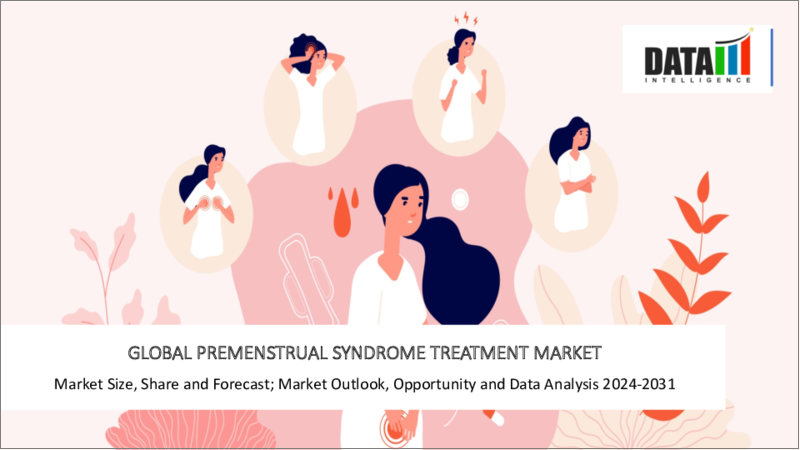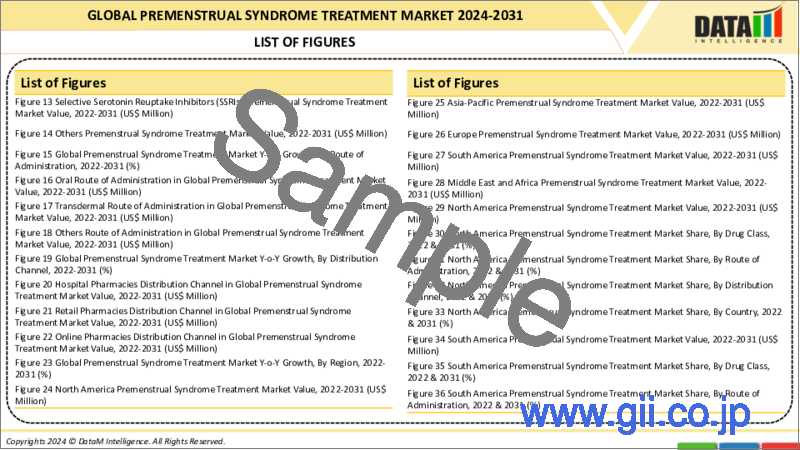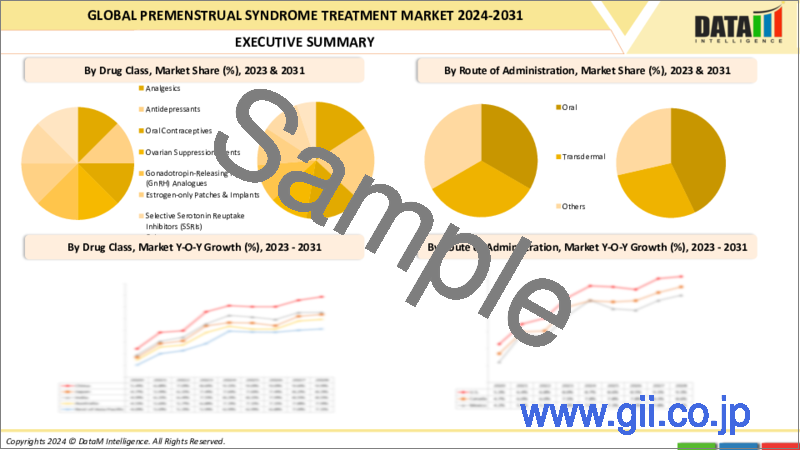|
|
市場調査レポート
商品コード
1138377
月経前症候群治療の世界市場 - 2022-2029Global Premenstrual Syndrome Treatment Market - 2022-2029 |
||||||
|
● お客様のご希望に応じて、既存データの加工や未掲載情報(例:国別セグメント)の追加などの対応が可能です。 詳細はお問い合わせください。 |
|||||||
| 月経前症候群治療の世界市場 - 2022-2029 |
|
出版日: 2022年10月18日
発行: DataM Intelligence
ページ情報: 英文 180 Pages
納期: 約2営業日
|
- 全表示
- 概要
- 目次
市場力学
月経前症候群治療の世界市場は、月経前症候群治療の重要性に対する世界の認知度の高まりや、政府・非政府組織による女性ヘルスケアへの取り組みの高まり、新たな治療法の開発など、いくつかの要因によって成長しています。
対象となる人口が多いことと、治療法の新たな開拓が市場成長の原動力となることが期待されます。
生殖年齢にある女性にとって最も一般的な健康問題であるため、対象となる人口が多いことが市場の原動力となります。Petranka Chumpalovaら2020年、Annals of General Psychiatry誌に掲載された研究によると、生殖年齢の女性の90%が、軽度から重度までさまざまないくつかの月経前症候群の症状を経験しているとのことです。そのうちの約20~40%が月経前症候群に、約2~8%が月経前不快気分障害(PMDD)に悩まされることが世界で確認されています。
月経前症候群の治療法を開発するための研究開発活動は、市場にプラスの影響を与えるものと思われます。例えば、PH80-PMD(フェリン・ファーマ社)をPRNで経鼻投与したところ、慢性的な投与を必要とせず、月経前の重要な時期に中等度から重度の月経前症候群の症状がプラセボと比較して有意に軽減することが臨床試験で証明されています。
アサリナ・ファーマは、重症で身体障害を伴う月経前症候群である月経困難症(PMDD)の治療薬として期待される製品を開発しています。同社の主力製品であるセプラノロンは、120名の月経前不快気分障害の女性を対象とした新たな第II相試験において、安全性および有効性の主要評価項目を達成しました。Sepranoloneは、GABA-A調節性ステロイド拮抗薬(GAMSA)として作用するファースト・イン・クラスの内因性低分子化合物です。
世界的に月経前症候群の診断、治療、診療報酬に関する認知度が高まっています。例えば、2019年6月、月経前不快気分障害(PMDD)に独自の分類コードが付与され、WHOの新しい国際疾病分類であるICD-11において、初めて精神疾患ではなく婦人科疾患として明確に分類されました。ICD-11にPMDDが含まれたことは、PMDDに対する医学的認知が世界的に高まり、PMDDが精神疾患ではなく、ホルモン性の疾患であるという科学的コンセンサスが高まっていることを示す重要な指標となります。PMDDは、WHOの現行ICD-10でも言及されていますが、間接的に「月経前緊張症候群」の下位分類として扱われています。
治療薬の使用に伴う副作用は、市場成長の妨げになると予想されます。
しかし、月経前症候群の治療薬使用に伴う副作用は、市場成長の妨げになると考えられます。例えば、選択的セロトニン再取り込み阻害剤(SSRI)の使用は、吐き気、無力症、疲労、性的機能不全、エネルギー低下などの有害事象を引き起こします。ゴナドトロピン放出ホルモン(GnRH)アナログは、骨密度への悪影響につながり、骨菲薄化の発症リスクを高めるため、長期間の使用は推奨されていません。
産業分析
月経前症候群治療の世界市場は、ポーターのファイブフォース、規制分析、サプライチェーン分析、価格分析など、様々な業界要因に基づいた市場の詳細な分析を提供します。
世界の月経前症候群治療市場レポートでは、約45+市場データ表、40+図、180ページの構成で提供しています。
目次
第1章 調査手法と調査範囲
- 調査手法
- 調査目的および調査範囲
第2章 市場の定義と概要
第3章 エグゼクティブサマリー
第4章 市場の力学
- 市場影響要因
- 促進要因
- 対象人口の拡大
- 治療法の開発
- 抑制要因
- 阻害要因:治療薬の使用に伴う副作用
- ビジネスチャンス
- 影響分析
- 促進要因
第5章 産業分析
- ポーターのファイブフォース分析
- 規制分析
- サプライチェーン分析
- 価格設定分析
第6章 薬物クラス別
- 鎮痛剤
- 抗うつ薬
- 経口避妊薬
- 卵巣抑制剤
- ゴナドトロピン放出ホルモン(GnRH)類似物質
- エストロゲンのみのパッチおよびインプラント
- 選択的セロトニン再取り込み阻害薬(SSRI)
- その他
第7章 販売チャネル別
- 病院内薬局
- ドラッグストアおよび小売薬局
- オンラインプロバイダー
- その他
第8章 地域別
- 北米
- 米国
- カナダ
- メキシコ
- 欧州
- ドイツ
- 英国
- フランス
- イタリア
- スペイン
- その他欧州
- 南米
- ブラジル
- アルゼンチン
- その他の南米地域
- アジア太平洋地域
- 中国
- インド
- 日本
- オーストラリア
- その他アジア太平洋地域
- 中東・アフリカ地域
第9章 競合情勢
- 主な展開と戦略
- 企業シェア分析
- 薬効分類のベンチマーク
- 注目の主要企業リスト
第10章 企業プロファイル
- Bayer AG
- 企業概要
- 薬物クラスのポートフォリオと説明
- 主なハイライト
- 財務概要
- Eli Lilly And Company
- GlaxoSmithKline Plc.
- H. Lundbeck A/S
- Pfizer Inc.
- Asarina Pharma AB
- Chattem, Inc.(Sanofi)
- Dekk-Tec
- Pherin Pharmaceuticals
- Novartis International AG
第11章 月経前症候群治療の世界市場-DataM
Market Overview
Premenstrual Syndrome Treatment Market size was valued US$ 1,367 million in 2021 and is estimated to reach US$ 1,829 million by 2029, growing at a CAGR of 4.1% during the forecast period (2022-2029).
Premenstrual Syndrome is a combination of physical and emotional symptoms, including mood swings, body pain, fatigue, tender breasts, food cravings, fatigue, irritability, and depression. It arises around the end of the luteal phase and dissipates with menstruation or briefly thereafter. It is most commonly observed among women with a high level of stress, depression, cyclic changes in the menstruation cycle, and chemical changes in the brain.
Market Dynamics
The global premenstrual syndrome treatment market is growing due to several factors such as growing awareness towards the significance of premenstrual syndrome treatment globally and rising government and non-government organizations initiatives doe women healthcare and various developments of new therapies.
Larger targeted population and new developments in therapies are expected to drive market growth.
The larger targeted population drives the market as it is the most common health problem in women of reproductive age. According to Petranka Chumpalova et al. 2020, in a study published in the Annals of General Psychiatry journal, 90% of women of reproductive age experience several premenstrual symptoms varying from mild to severe. Approximately 20-40% of those women suffer from Premenstrual Syndrome, and around 2-8% of those women suffer from the premenstrual dysphoric disorder (PMDD) worldwide.
The undergoing research and development activities to develop therapies for Premenstrual Syndrome shall positively impact the market. For instance, the clinical studies demonstrated that the administration of the PH80-PMD (Pherin Pharmaceuticals) administered intranasally PRN decreased moderate and severe premenstrual symptoms significantly better compared to the placebo during the critical premenstrual days of the cycle without the need for chronic administration.
Asarina Pharma is developing a potential therapy for the treatment of Premenstrual Dysphoric Disorder (PMDD), a severe and disabling form of premenstrual syndrome. Its lead product, i.e., Sepranolone, had met its primary safety and efficacy endpoints in a new Phase II study involving 120 women with Premenstrual Dysphoric Disorder. Sepranolone is a proprietary, first-in-class, endogenous, small molecule that acts as a GABA-A modulating steroid antagonist (GAMSA).
There is an increase in awareness regarding the diagnosis, treatment, and reimbursement of premenstrual syndrome worldwide. For instance, in June 2019, Premenstrual dysphoric disorder (PMDD) has been given its own classification code and, for the first time, classified clearly as a gynecological, not mental, disease in the WHO's new International Classification of Diseases, ICD-11. The inclusion of PMDD in ICD-11 is an important indicator of the growing medical awareness of PMDD worldwide and a growing scientific consensus that PMDD is a hormonal, not psychiatric condition. PMDD is mentioned in the WHO's present ICD-10, but indirectly as a sub-classification under 'Premenstrual tension syndrome.
Side-effects associated with use of therapies are expected to hamper the market growth.
However, the side-effects associated with the use of therapies for premenstrual syndrome shall hider market growth. For instance, the use of selective serotonin reuptake inhibitors (SSRIs) results in adverse events such as nausea, asthenia, fatigue, sexual dysfunction, and decreased energy. Gonadotropin-releasing hormones (GnRH) analogs are not recommended for the long term as these analogs lead to adverse effects on bone density and increase the risk of developing bone thinning.
Industry Analysis
The global premenstrual syndrome treatment market provides in-depth analysis of the market based on various industry factors such as Porter's Five Forces, Regulatory Analysis, Supply Chain Analysis, Pricing Analysis.
Segment Analysis
Product type segment is expected to hold the largest market share in global premenstrual syndrome treatment market
The premenstrual syndrome treatment market is segmented based on product type as analgesics, antidepressants, oral contraceptives agents, ovarian suppression agents, gonadotropin-releasing hormone (GnRH) analogs, estrogen-only patches & implants, selective serotonin reuptake inhibitors (SSRIs), and others. The analgesics segment accounts for the highest market share owing to the higher uptake of analgesics as it is the mainstay treatment for premenstrual syndrome. Various analgesics such as ibuprofen, acetaminophen, diclofenac, naproxen is used for the management of premenstrual syndrome. These analgesics are effective in reducing stomach cramps, headache, muscle pain, joint pain and others.
The oral contraceptive agent segment is expected to have positive market growth due to the rising usage of oral contraceptive agents to manage the physical and psychiatric symptoms of premenstrual syndrome. The oral contraceptive agents, including the levonorgestrel/ Ethinyl estradiol, drospirenone and others, are used to even out the ovarian hormone fluctuations. Clinical studies have demonstrated that the administration of 90 mcg levonorgestrel/20 mcg Ethinyl estradiol resulted in improvement in depressive and physical symptoms.
The antidepressant segments account for the significant market share over the forecasted period. The antidepressants act by increasing the brain chemicals, including opioids, serotonin, and others hampered due to the ovarian hormones. Serotonin reuptake inhibitors (SSRIs) are recommended for treating the mood changes associated with Premenstrual Syndrome. The market is dominated by the availability of several serotonin reuptake inhibitors, including Fluoxetine (Prozac), paroxetine (Paxil), Sertraline (Zoloft), citalopram (Celexa) and escitalopram (Lexapro) for the treatment of psychiatric symptoms associated with Premenstrual Syndrome. The clinical studies demonstrated that these five serotonin reuptake inhibitors (SSRIs) have statistically significant benefits on patient-reported symptoms when taken continuously or only during the luteal phase.
Further, the market is also classified based on distribution channel as hospital pharmacies, drug stores & retail pharmacies, online providers, and others. The drug stores & retail pharmacies segment are expected to have the highest market share due to many drug stores & retail pharmacies worldwide. The majority of the drugs being used for the premenstrual syndrome are the counter drugs, which are easily available over the counter without a prescription. It is further expected that the drug stores & retail pharmacies segment shall lose its market share with the rising growth of online providers worldwide over the forecasted period.
The online provider's segment is expected to have significant market growth due to the growing preference for online purchasing of drugs compared to the traditional methods, including the drug stores & retail pharmacies and hospital pharmacies. The rising awareness regarding online providers, growing internet users, and digital transformation shall stimulate market growth. Hence, it is expected that online providers shall account for the highest market share over the forecasted period.
Geographical Analysis
North America region holds the largest market share in the global premenstrual syndrome treatment market
By region, the premenstrual syndrome treatment market is segmented into North America, South America, Europe, Asia-Pacific, Middle-East, and Africa. Among all of the regions, North America dominated the premenstrual syndrome treatment market due to the rising prevalence of premenstrual syndrome. According to the American Academy of Family Physicians, in 2020 approximately 90% of childbearing age women experience premenstrual symptoms, and less than 10% are diagnosed with the premenstrual dysphoric disorder (PMDD). The growing awareness regarding women's health shall stimulate market growth. For instance, The Office on Women's Health (OWH) within the U.S. Department of Health and Human Services (HHS) is involved in creating awareness by addressing the critical women's health issues. It helps inform and advance policies, educate professionals and consumers, and support programs related to women's health, including the premenstrual syndrome.
The Asia-Pacific is expected to have positive market growth due to many females of childbearing age. There are growing government initiatives and campaigns for improving women and maternity health. For instance, India's National Health Portal creates awareness of women's health issues, including premenstrual syndrome. The rising expenditure for improving the healthcare facilities and infrastructure shall have a positive impact on the market. Substantial market growth is expected to be observed in developing countries, including India & China.
Competitive Landscape
Bayer AG, Eli Lilly and Company, GlaxoSmithKline Plc, Pfizer Inc., H. Lundbeck A/S, Pfizer Inc., Asarina Pharma AB, Chattem, Inc. (Sanofi), Dekk-Tec, Pherin Pharmaceuticals, Novartis International AG are the leading market players with significant market share. The new product development, opportunity, and revenue generation shall intensify the market competition.
The companies use strategies such as collaborations, mergers, strategic partnerships, and acquisitions to hold their positions in the market. For instance, In Aug 2020, Bayer's acquired KaNDy Therapeutics Limited to boost their female healthcare business.
Key Companies to Watch
Bayer AG:
Overview: Bayer is a biotech and pharmaceutical multinational company. It was founded in 1863 and is headquartered in Leverkusen, Germany. Their business area includes pharmaceutical, agriculture chemicals, healthcare products and biotechnology products.
Product Portfolio:
vissane: It is a progestin medication that is generally used in birth control pills and is used to treat heavy periods and for menopausal hormone.
Key Developments: In Aug 2020, Bayer's acquired KaNDy Therapeutics Limited to boost their female healthcare business.
The global premenstrual syndrome treatment market report would provide an access to an approx. 45+market data table, 40+figures and 180pages.
Table of Contents
1. Methodology and Scope
- 1.1. Research Methodology
- 1.2. Research Objective and Scope of the Report
2. Market Definition and Overview
3. Executive Summary
4. Market Dynamics
- 4.1. Market Impacting Factors
- 4.1.1. Drivers:
- 4.1.1.1. Larger targeted population
- 4.1.1.2. Development of therapies
- 4.1.2. Restraints:
- 4.1.2.1. Side-effects associated with the use of therapies
- 4.1.3. Opportunity
- 4.1.4. Impact Analysis
- 4.1.1. Drivers:
5. Industry Analysis
- 5.1. Porter's Five Forces Analysis
- 5.2. Regulatory Analysis
- 5.3. Supply Chain Analysis
- 5.4. Pricing Analysis
6. By Drug Class
- 6.1. Introduction
- 6.1.1. Market Size Analysis, and Y-o-Y Growth Analysis (%), By Drug Class Segment
- 6.1.2. Market Attractiveness Index, By Drug Class Segment
- 6.2. Analgesics
- 6.2.1.1. Introduction
- 6.2.1.2. Market Size Analysis, US$ Million, 2020-2029 and Y-o-Y Growth Analysis (%), 2021-2029
- 6.3. Antidepressants
- 6.4. Oral Contraceptives
- 6.5. Ovarian Suppression Agents
- 6.6. Gonadotropin-releasing hormone (GnRH) Analogues
- 6.7. Estrogen-only patches & implants
- 6.8. Selective serotonin reuptake inhibitors (SSRIs)
- 6.9. Others
7. By Distribution Channel
- 7.1. Introduction
- 7.1.1. Market Size Analysis, and Y-o-Y Growth Analysis (%), By Distribution Channel Segment
- 7.1.2. Market Attractiveness Index, By Distribution Channel Segment
- 7.2. Hospital Pharmacies
- 7.2.1.1. Introduction
- 7.2.1.2. Market Size Analysis, US$ Million, 2020-2029 and Y-o-Y Growth Analysis (%), 2021-2029
- 7.3. Drug Stores and Retail Pharmacies
- 7.4. Online providers
- 7.5. Others
8. By Region
- 8.1. Introduction
- 8.1.1. Market Size Analysis, US$ Million, 2020-2029 and Y-o-Y Growth Analysis (%), 2021-2029, By Region
- 8.1.2. Market Attractiveness Index, By Region
- 8.2. North America
- 8.2.1. Introduction
- 8.2.2. Key Region-Specific Dynamics
- 8.2.3. Market Size Analysis, and Y-o-Y Growth Analysis (%), By Drug Class
- 8.2.4. Market Size Analysis, and Y-o-Y Growth Analysis (%), By Distribution Channel
- 8.2.5. Market Size Analysis, and Y-o-Y Growth Analysis (%), By Country
- 8.2.5.1. U.S.
- 8.2.5.2. Canada
- 8.2.5.3. Mexico
- 8.3. Europe
- 8.3.1. Introduction
- 8.3.2. Key Region-Specific Dynamics
- 8.3.3. Market Size Analysis, and Y-o-Y Growth Analysis (%), By Drug Class
- 8.3.4. Market Size Analysis, and Y-o-Y Growth Analysis (%), By Distribution Channel
- 8.3.5. Market Size Analysis, and Y-o-Y Growth Analysis (%), By Country
- 8.3.5.1. Germany
- 8.3.5.2. U.K.
- 8.3.5.3. France
- 8.3.5.4. Italy
- 8.3.5.5. Spain
- 8.3.5.6. Rest of Europe
- 8.4. South America
- 8.4.1. Introduction
- 8.4.2. Key Region-Specific Dynamics
- 8.4.3. Market Size Analysis, and Y-o-Y Growth Analysis (%), By Drug Class
- 8.4.4. Market Size Analysis, and Y-o-Y Growth Analysis (%), By Distribution Channel
- 8.4.5. Market Size Analysis, and Y-o-Y Growth Analysis (%), By Country
- 8.4.5.1. Brazil
- 8.4.5.2. Argentina
- 8.4.5.3. Rest of South America
- 8.5. Asia Pacific
- 8.5.1. Introduction
- 8.5.2. Key Region-Specific Dynamics
- 8.5.3. Market Size Analysis, and Y-o-Y Growth Analysis (%), By Drug Class
- 8.5.4. Market Size Analysis, and Y-o-Y Growth Analysis (%), By Distribution Channel
- 8.5.5. Market Size Analysis, and Y-o-Y Growth Analysis (%), By Country
- 8.5.5.1. China
- 8.5.5.2. India
- 8.5.5.3. Japan
- 8.5.5.4. Australia
- 8.5.5.5. Rest of Asia Pacific
- 8.6. Middle East and Africa
- 8.6.1. Introduction
- 8.6.2. Key Region-Specific Dynamics
- 8.6.3. Market Size Analysis, and Y-o-Y Growth Analysis (%), By Drug Class
- 8.6.4. Market Size Analysis, and Y-o-Y Growth Analysis (%), By Distribution Channel
9. Competitive Landscape
- 9.1. Key Developments and Strategies
- 9.2. Company Share Analysis
- 9.3. Drug Classs Benchmarking
- 9.4. List of Key Companies to Watch
10. Company Profiles
- 10.1. Bayer AG
- 10.1.1. Company Overview
- 10.1.2. Drug Class Portfolio and Description
- 10.1.3. Key Highlights
- 10.1.4. Financial Overview
- 10.2. Eli Lilly And Company
- 10.3. GlaxoSmithKline Plc.
- 10.4. H. Lundbeck A/S
- 10.5. Pfizer Inc.
- 10.6. Asarina Pharma AB
- 10.7. Chattem, Inc. (Sanofi)
- 10.8. Dekk-Tec
- 10.9. Pherin Pharmaceuticals
- 10.10. Novartis International AG
LIST NOT EXHAUSTIVE
11. Global Premenstrual Syndrome Treatment Market - DataM
- 11.1. Appendix
- 11.2. About Us and End User
- 11.3. Contact Us




